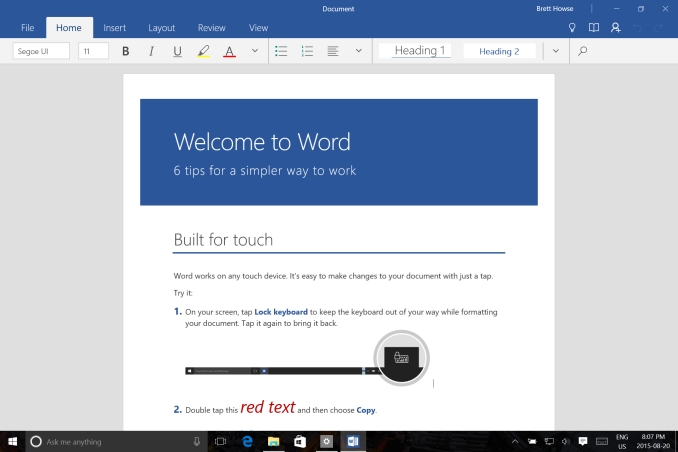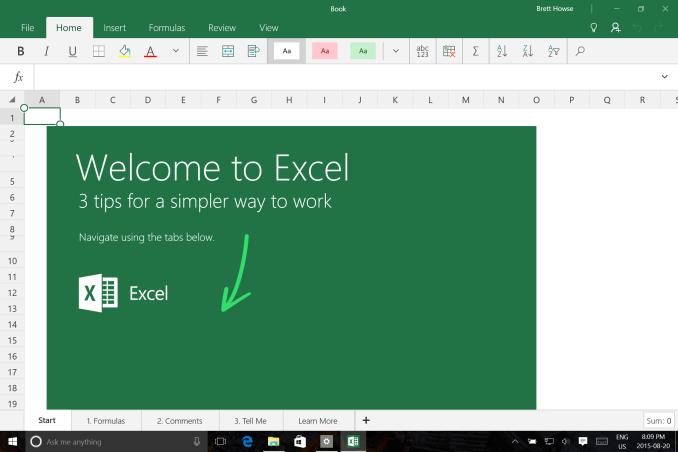The Windows 10 Review: The Old & New Face of Windows
by Brett Howse on August 25, 2015 8:00 AM EST- Posted in
- Operating Systems
- Microsoft
- Windows 10
Touch-Enabled Office Apps Arrive with Windows 10
When Windows 8 launched, Microsoft had built a touch-first version of their operating system, but they had not yet completed their touch-enabled version of their most popular productivity suite. In fact, in the almost three years between Windows 8 and Windows 10, Microsoft released Office on iOS first, and then Android, leaving their own platform as the only one without a touch-enabled version of Office. Finally, with Windows 10, Office Mobile is here.
These are, like practically all pieces of Windows 10, Windows Universal Apps, and therefore they are made to scale all the way from a phone to a large display desktop. Word, Excel, PowerPoint, and OneNote are all available. The experience is very similar to how it looks on the other platforms, and Microsoft has done a nice job keeping the look and feel consistent across the different mobile operating systems.
I think most people are familiar with the Office trio of Word, Excel, and PowerPoint, and perhaps not quite as familiar with OneNote, but the mobile apps are surprisingly competent versions, and can likely easily replace the full Office suite for a lot of people. If you need some of the extra functionality like conditional formatting in Excel, or the ability to open password protected documents, you will need to go with the full version of Office, at least for now.
In pretty typical Microsoft fashion, the apps have been created to allow basic file reading, creation, and editing for free, but if you want to access all of the features you need to purchase an Office 365 subscription. There is a big caveat here though. This only applies to devices under 10.1 inches in screen diameter. Anything larger than this requires a subscription to gain access to edit, which is a pretty big concession. According to Microsoft, they want to keep the free capabilities available for devices that are mostly used with touch, and the Office team feels this cut-off is 10.1 inches. Amazingly, the same company also sells a consumer version of their tablet line, the Surface 3, which is a 10.8 inch device and therefore over the cut-off. They do sell it with a one year subscription, but it’s a rather odd way to market the new Office Mobile apps.
There is also a new piece to the Office puzzle, which is called Sway. Luckily, like OneNote, Sway is free for all users. So what is Sway? It is an interactive storytelling app, and it lets you easily add some text and media, and it will create a sway for you. It’s very much a cloud based app, and you can share links to your sway to view or edit. Think of it like a simpler version of PowerPoint. Here is a sway as an example of what it can do.
OneNote is of course back, and this is Microsoft’s app which lets you do a lot more than just take notes. The touch version is changed from Windows 8, and it now fits in with the theme of the other Office Mobile apps. Fans of the Windows 8 version’s radial menu will be disappointed though since that has gotten the axe.
I think the capabilities of these apps are going to improve over time, but it is unlikely they will ever offer the full functionality of the desktop version of Office. They are targeted towards a different set of needs. It was certainly one of the key missing pieces of the Windows 8 era, so it is great that they have made their debut with Windows 10. Only OneNote is installed out of the box, and the other apps can be found in the store.














293 Comments
View All Comments
phoenix_rizzen - Tuesday, August 25, 2015 - link
http://arstechnica.com/gadgets/2015/07/how-to-do-a...Margalus - Wednesday, August 26, 2015 - link
once you upgrade to win 10, you cannot upgrade again. You have to do a clean install with 10 after the upgrade is done. There are no problems then.jjj - Tuesday, August 25, 2015 - link
Win 10 feels like Microsoft is about to slip something in your drink and that's not acceptable.The likelyhood of DRM hardware seems very high. I suspect that was added to protect Oculus, to not let users buy a 50$ headset (intead of paying up to 10 times more for Oculus- for no good reason) and use just the Oculus software/store. But it won't be limited to just Oculus and hell knows how bad it can get in the years to come, especially when the press is more than happy to pretend all is ok. Any review should start and end by urging users not to touch it. Don't let Microsoft take over your machine.
Flunk - Tuesday, August 25, 2015 - link
If you're running any copy of Windows you're too late to avoid Microsoft taking over your machine.sorten - Tuesday, August 25, 2015 - link
You think Microsoft modified their OS to favor a Facebook product?prophet001 - Tuesday, August 25, 2015 - link
Absolutely.How are people so naive as to believe there will be no form of 'payment' for something given to you for 'free'? Really? Have we learned nothing?
Notmyusualid - Tuesday, August 25, 2015 - link
The 'if it is free - you are the product', does not apply here.There are paid editions of Win 10 too.
inighthawki - Tuesday, August 25, 2015 - link
It is not free, it is a free upgrade to users who already purchased a previous edition. Big difference. Users who do not own windows or are buying a new PC still pay for a new license. Windows 10, like every version of windows before it, is not a free product.Gigaplex - Wednesday, August 26, 2015 - link
And it's only a free upgrade for a limited time.chrome_slinky - Wednesday, August 26, 2015 - link
It is FREE for NO ONE. It is, at best, a LICENSE TRADE. [and not a good one, as you have no concrete proof of your license - should the Microshaft server ever get compromised, you may be screwed]